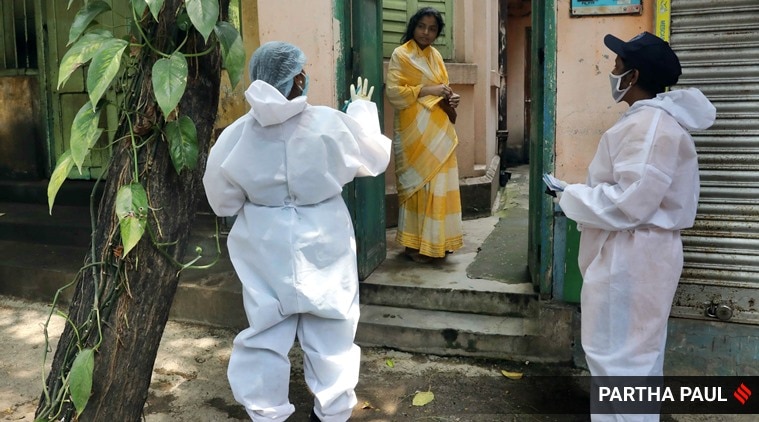 Ever since the arrival of the IMCTs, there has been an unmistakable change in Bengal’s approach to the pandemic. (Express file photo by Partha Paul)
Ever since the arrival of the IMCTs, there has been an unmistakable change in Bengal’s approach to the pandemic. (Express file photo by Partha Paul)
When two Inter-Ministerial Central Teams (IMCTs) landed in Kolkata on April 21 to assess the situation in seven Covid-hit districts of West Bengal, the ruling TMC reacted angrily, saying the Centre was fighting states when states were fighting the coronavirus.
But that was then.
Ever since the arrival of the IMCTs, there has been an unmistakable change in the state’s approach to the pandemic. It has tightened measures on the ground to contain the spread of the virus, enforced lockdown rules strictly in containment zones, increased testing of samples, given hospitals a free hand in treatment of patients, changed the format of its medical bulletins to reflect real-time case data, and ordered all district magistrates to submit daily reports on containment zones.
Consider the following:
In two red zones that accounted for more than 50 per cent of the positive cases in the state, guard rails came up in areas like Belgachia, Narkeldanga, Rajabazar, Park Circus, Metiabruz, Tangra, Beltala, parts of Patuli in Kolkata; and Howrah Maidan, Kazipara, Shibpur, Tikiapara, Salkia, Netaji Subhash Road in Howrah.
Several congested markets were shifted to open fields in different parts of the state and those near containment areas were shut down.
From April 21, Chief Minister Mamata Banerjee hit the streets of Kolkata, speaking directly to the people, urging them to stay indoors.
On April 24, Chief Secretary Rajiva Sinha disclosed the finding of the special audit committee on Covid-related deaths. He said there had been 57 deaths but only 18 were due to COVID-19 and the rest were those with comorbidity.
The state stepped up testing efforts. From 400-450 tests a day, the daily average climbed to 800 April 21 onward. It reached 2201 on May 4.
On April 29, the Chief Minister formed a cabinet committee to deal with COVID-19 in the state. Top state officials were inducted into the panel. The committee was formed after doctors, at a meeting with the CM, red-flagged the situation in the state.
On April 30, an advisory was issued to all hospitals, private and state-run, clarifying that “no government approval is required for admitting and treating any patient in any health care facility or for testing an individual for COVID as per ICMR testing protocols”. Hospitals were also told not to turn away patients.
Explained | Why liquor matters to states
On April 30, the Chief Secretary told a press conference that there had been 105 deaths but only 33 could be directly attributed to COVID-19.
The death audit committee, Sinha said, would no longer evaluate all deaths and doctors were being advised to follow protocols. “The Death Audit Committee has recommended that Health Department officials should keep more records of patients and advised them to improve the procedure of keeping records. The committee also advised that there should be a uniform format to issue death certificates. The committee advised that the death certificate should have immediate cause of death, antecedent cause of death and underlying cause of death,” Sinha said.
Chief Minister Banerjee told reporters on April 29: “People are raising a hue and cry over who is issuing what kind of order. We have to correct ourselves because we make mistakes.”
On April 30, the Medical Superintendent of Murshidabad Medical College and Hospital, was transferred, five days after a duty roster he signed said “in case of Covid positive, no mention of covid D/C (death certificate)”.
On May 4, Chief Secretary Sinha, while announcing that the state government will henceforth release information on the total number of Covid-infected patients instead of active cases, said hospitals will now hand death certificates. But he said hospitals have been told not to report co-morbidity deaths.
“We found that the reporting structure of our state was highly complicated. All cases were not being recorded properly. We thought the process was dynamic, but it proved otherwise. So, we changed the structure and made a system on real-time data,” Sinha said.
In the last 24 hours, the state tested 2201 samples. Till date, 25,116 samples have been tested, 4,860 people are in government quarantine centres and another 5,755 in home quarantine.